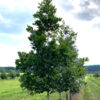
February’s Featured Native is Pinus virginiana. Commonly called Virginia or scrub pine (or Jersey pine in a certain state to our northeast), Pinus virginiana has been a long-ignored native evergreen that has in recent years become more prominent in the naturalized landscape. With a native range spanning the East Coast from Long Island to the Chesapeake, then southwestward through the Blue Ridge and Great Smokies to the Cumberland Plateau, it is an adaptable and fast-growing species. Along with P. rigida, the pitch pine, it is a primary species of the well-known Pine Barrens ecological area of southern New Jersey.
In its native range, P. virginiana tends to grow in almost pure stands, usually maturing at 30-60 ft in height. In the landscape under more ideal conditions, it can grow taller; up to 75 ft. The largest recorded specimen topped out at 105 ft. Broadly pyramidal in youth, it tends to grow more contorted with age, developing a broad, flat-topped, irregular, and ragged crown that serves as an interesting focal point in the landscape. The orange, brown and cinnamon-colored bark and short, sharp, paired needles often lead to confusion with Pinus sylvestris (Scots pine), a poorly-adapted species which was extensively used in the landscape in the first half of the 20th century. It can be distinguished by its yellow-green, twisted needles and 2½” ovoid cones, compared to the flat, blue-green needles and short, squat cones of P. sylvestris. Unlike most pines, the cones of Virginia pine develop over two seasons. The female flowers emerge in the spring and are fertilized by the bright yellow pollen-bearing strobili the following spring, then mature in the autumn. Cones are produced every year, with some individuals bearing a heavier crop every third year; they can persist on the tree for up to fifteen years. In good growing situations, the tree can grow to 18 ft in its first ten years and bear cones at five years of age. Virginia pine is

especially useful in the landscape due to its tolerance for a variety of soil conditions; while it prefers a well-drained sandy or loamy soil, it can also thrive in drier, rockier soils, albeit with a slower growth rate and is relatively drought-tolerant compared to most evergreens.
Virtually all parts of the tree were used by native Cherokee peoples; tonics from the needles and bark for ailments such as bowel problems, fevers, and tuberculosis, tea from needles steeped in apple juice as a tonic, root tonic as a stimulant, pine tar as a waterproofing agent, and branches in burial rituals. European settlers found the wood useful for poles and ship masts as unlike most pine, the wood becomes harder and stiffer as it dries due to crystallization of the high pitch content. Today, P. virginiana is often grown as a Christmas tree and is an important and renewable source of wood pulp for paper-making.

In the landscape, Virginia pine is useful as a backdrop to a shrub border, as a provider of high, light shade for annuals and perennials easily scorched by direct sunlight or as a picturesque specimen. It can be affected by the fungal pathogens Porodaedalea pini and Fusarium moniliforme and insects such as pine beetles and sawflies. All of these are relatively uncommon in the landscape and can be mitigated by good cultural practices.
White House Natives supplies Pinus virginiana in sizes from 5 ft to 8 ft. It is a unique and interesting native that deserves a spot in the larger garden.



![At the Nursery: Budding Out [Part 3]](https://whitehousenatives.com/wp-content/uploads/2024/04/Carpinus-caroliniana-catkins-100x100.jpg)
![At the Nursery: Budding Out [Part 2]](https://whitehousenatives.com/wp-content/uploads/2024/04/Acer-rubrum-seed-pods-100x100.jpg)
![At the Nursery: Budding Out [Part 1]](https://whitehousenatives.com/wp-content/uploads/2024/04/Liriodendron-tulipifera-leaf-out-100x100.jpg)